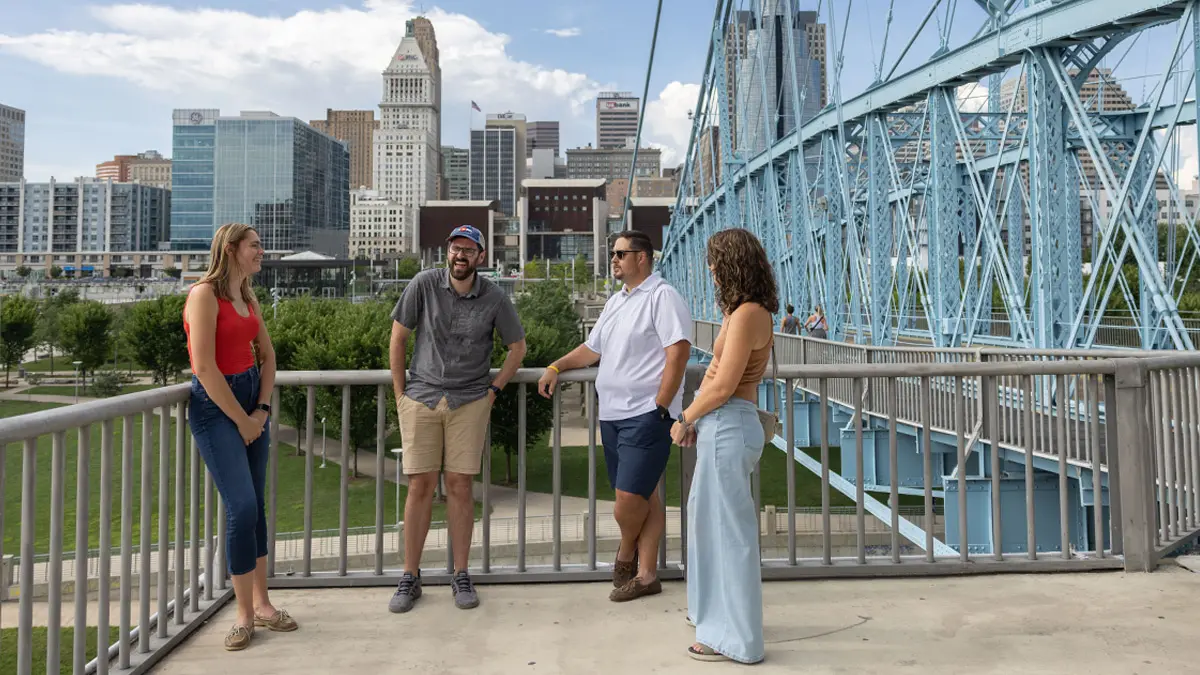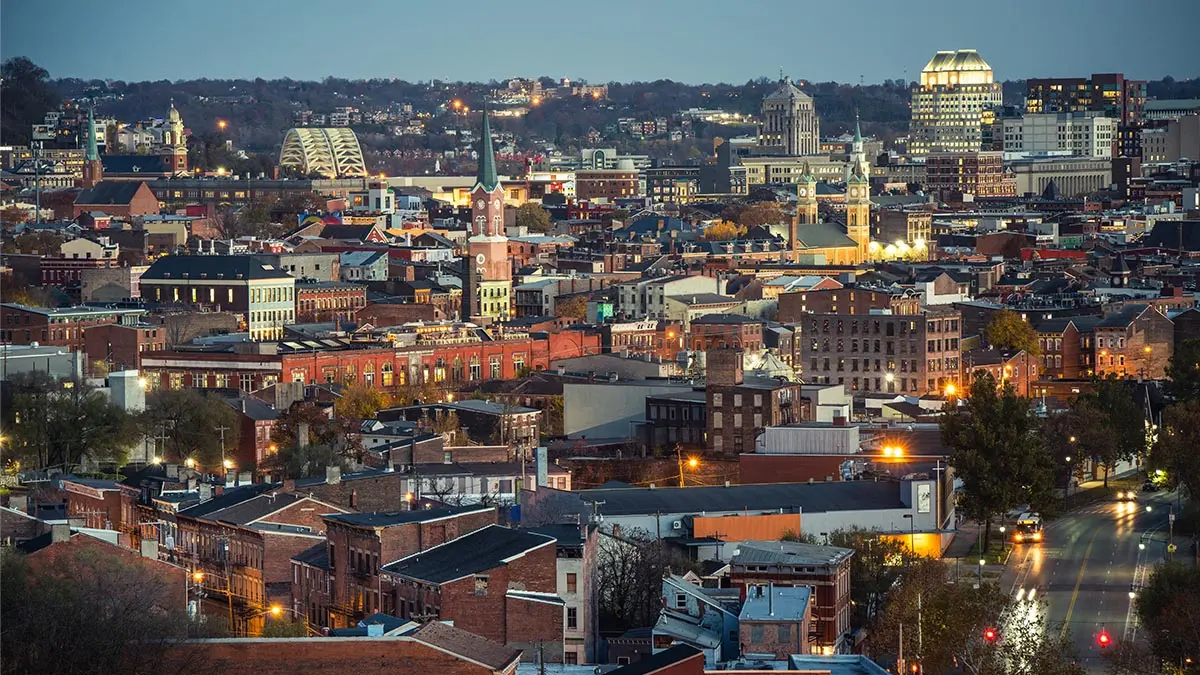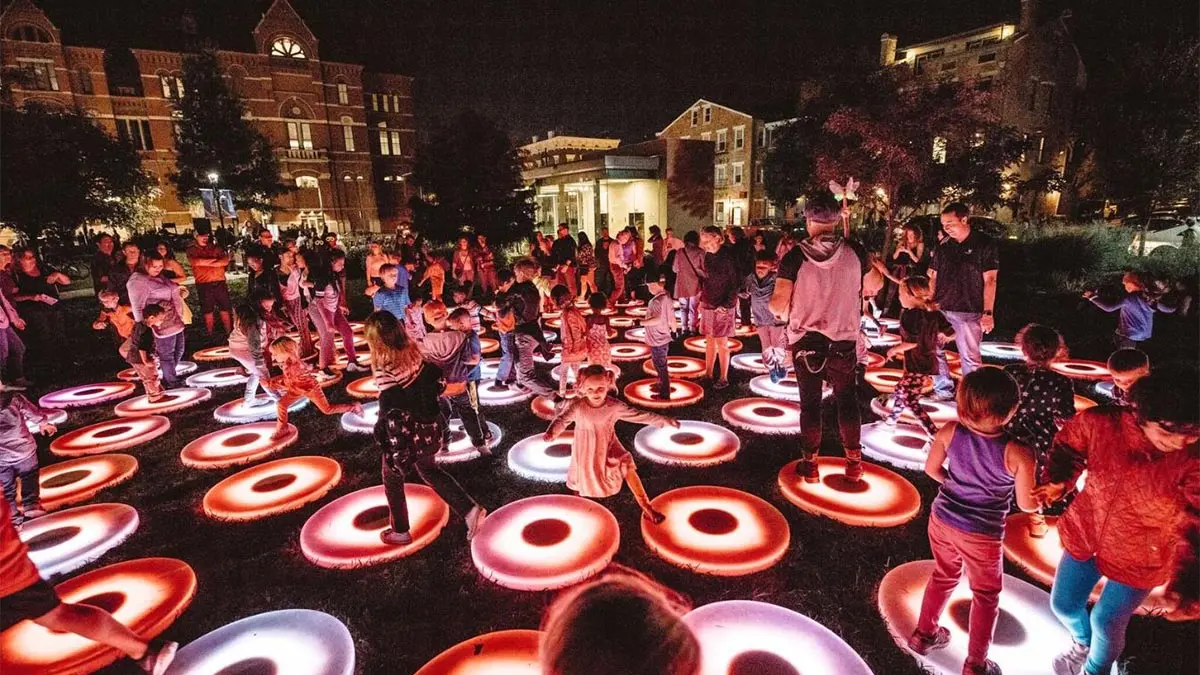Where I Live: It’s Cincinnati’s time to shine
With Buckeyes, the Bengals and beloved places to explore and dine, the “we can do it!” spirit is strong in the Queen City.

Alumni Erin Davis, Jacob Farr, Eric Davis and Jessica Farr chat on the Roebling Bridge, which links downtown Cincinnati to Covington, Kentucky.
Early one morning in January, Cincinnatian Erin Davis ’12, ’14 MPA went for a run and was amazed at what she saw against the still dark sky: downtown buildings glowing orange. The Cincinnati skyline had been lit up in support of the Bengals’ playoff run to the Super Bowl, the NFL team’s first appearance there since the 1988 season.
“I have loved the pride” that has swirled around the city thanks to the Bengals and quarterback Joe Burrow ’18, Davis says. “Feels like the team is drafting and creating a culture of community. I felt it all season. It just felt like a family.”
Not surprisingly, Mayor Aftab Pureval ’05 shares Davis’ enthusiasm for their team and city.
“There’s no doubt that the Bengals’ historic run to the Super Bowl was a boost to our city. Like the Bengals, Cincinnati is incredibly young and incredibly diverse,” says Pureval, the city’s first Asian American mayor. “Cincinnati has created incredible momentum for the future.” He’s particularly proud of the “world-class arts, businesses and philanthropies in our city.”
To get to know the destination he says belongs on the world stage, the mayor has a recommendation: “Jump on our streetcar, which takes you to several different neighborhoods.” And all for free. Not only is it an easy way to get to Paul Brown Stadium to see the Bengals, the Cincinnati Bell Connector stops all around downtown, including at the Rosenthal Center for Contemporary Art; Washington Park, part of a park system ranked fourth best in the country; Fountain Square; the Music Hall, home to the Cincinnati Symphony Orchestra and Cincinnati Opera; and Findlay Market in the popular Over-the-Rhine neighborhood.
Findlay Market has “incredible restaurants and incredible food stalls,” says Pete Metz ’11. Ohio’s oldest continuously operating public market, it often has served as an incubator for restaurants, such as Taste of Belgium. Founded in the market in 2007, Taste of Belgium now serves waffles, other Belgian-inspired food, beer and other beverages in six additional locations around the city, including in The Banks.
Taste of Belgium is one place Davis likes to visit after a Bengals game. Another is Tin Roof, a restaurant, bar and live music joint also in The Banks. For a pre-game meal, or just to pre-game, Davis recommends Knockback Nats and O’Malleys in the Alley, both within walking distance of the stadium.
While Over-the-Rhine is on the National Register of Historic Places, The Banks is a newer mixed-use development drawing a lot of attention. Nestled along the Ohio River between the Bengals’ and Reds’ stadiums, The Banks features a park, restaurants, bars, shops, residences and offices.

The popular and historical Over-the-Rhine neighborhood is located just north of downtown’s business district. (Photo from Getty Images)
“If you’re a person who likes to sit on a patio and eat,” The Banks has a place for you, says Betsy Donahoe-Filmore ’88, president of the Alumni Club of Greater Cincinnati. One of her favorites is Montgomery Inn’s Boathouse. The original inn opened in 1951 in the village of Montgomery, northeast of downtown. Although best known for its ribs (and that sauce!), she says, “The salmon is incredible there,” and the Saratoga chips are “a guilty pleasure.” Judy Halak ’91 likes the ribs and pulled pork sandwich.
Another staple of the Queen City is LaRosa’s Pizzeria, founded in 1954 and now with multiple locations in Greater Cincinnati. “I like the pizza,” Halak says, and “they’re a local Italian family.”
If you’re talking culinary staples of the city, the conversation must include the food with “Cincinnati” cooked right into the name: Cincinnati chili, with its spiced meat sauce served over a plate of spaghetti or a hot dog and under a mountain of cheese.
“I just had it the other night,” Halak says. Where does she get her chili on? “It’s always been Skyline.”
Metz, too: “I’m a total purist for Skyline Chili.” He prefers the restaurant at Clifton and Ludlow avenues. “It’s got an iconic feel to it.”
Davis also is partial to Skyline, where she worked in high school. But if you want to try a nonchain restaurant, she suggests Blue Ash Chili or Camp Washington Chili.
The original Skyline, which opened in 1949 in the West Price Hill neighborhood, no longer exists. But it left its legacy in the name, which the founding Lambrinides family drew from its panoramic view of downtown.
Queen City canvas
The Bengals may not be playing at home October 16, but that doesn’t mean you should snooze on Cincinnati that weekend. In fact, best to keep your eyes wide open for Blink Cincinnati, an outdoor light and art projection experience encompassing 30 downtown blocks October 13–16.
“It’s a festival, and you come to the city and you walk. It’s a really awesome experience,” says Pete Metz, who works for the Cincinnati USA Regional Chamber, Blink’s coordinator. At night, the downtown buildings are treated as “a big white canvas” and works of art are projected onto them.
This is the third time Cincinnati has hosted Blink. In 2019, more than 1.25 million people attended, making it what organizers say was the region’s largest event ever.
Part of Cincinnati’s growth “has been led by our arts and culture sector,” says Mayor Aftab Pureval. Some of the art to be projected at Blink has been commissioned by the city’s nonprofit ArtWorks, through which professional artists mentor high school students. Pureval proudly describes it as a program for violence prevention, summer employment and arts contribution.
And because the festival is at night, Metz says, it’s a “good anchor for you to say, ‘I’m going to stay the weekend in Cincinnati.’”

This shows one scene from a previous Blink Cincinnati, which in 2019 set a record as the region’s largest-ever event, according to festival organizers.
Interesting facts about Cincinnati
Quarterback Joe Burrow’s No. 9 jersey ranked fourth in NFL jersey sales for the year starting March 1, 2021.
Union Terminal, an art deco railroad station built in the 1930s, now houses several museums, including the Cincinnati History Museum, the Children’s Museum and the Museum of Natural History and Science. Its recent restoration was finished in 2018 to the tune of about $213 million.
Cincinnati was one of 21 cities in North America named finalists for hosting matches in the 2026 FIFA World Cup.
You may hear a lot of “Who Dey?” around Cincinnati during football season, but that’s only part of the cheer. The whole thing goes: “Who dey, who dey, who dey think gonna beat dem Bengals?” And the response is, “Nobody!”
Cincinnati is home to the country’s largest unfinished subway tunnel. It was built between 1920 and 1923 and runs for 2 miles under Central Parkway, between Walnut Street and a spot north of the Western Hills Viaduct.
Join the club
Looking for fellow Buckeyes in the Queen City? Catch up with the Alumni Club of Greater Cincinnati.



